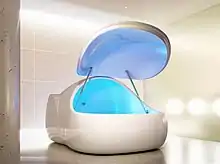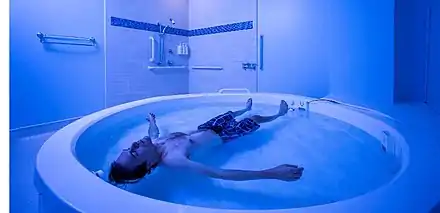Isolation tank
An isolation tank, sensory deprivation tank, float tank, float pod, float cabin, flotation tank, or sensory attenuation tank is a water filled, pitch-black, light-proof, soundproof environment heated to the same temperature as the skin, developed in 1954 by John C. Lilly.
| This article is part of a series on |
| Alternative medicine |
|---|
 |

Flotation tanks are widely advertised as a form of alternative medicine but beneficial health effects are unproven.
Method
The tank is filled with 10 inches of water which contains enough dissolved Epsom salt to create a specific gravity of approximately 1.25–1.26. This environment allows an individual to float effortlessly on the surface of the water.
History
The isolation tank was developed in 1954 by John C. Lilly, a medical practitioner and neuropsychiatrist.[1][2][3] During his training in psychoanalysis at the US National Institute of Mental Health (NIMH), Lilly experimented with sensory deprivation.[4]
Widespread commercial interest and use of the isolation tank did not occur until 1972, when Glenn Perry, a computer systems programmer, began selling the first commercial tanks after he attended a five-day workshop by Lilly.[5]
In 1981, there were about $4 million in sales and rentals in the industry, and expectations were that the market would grow, spurred by the film Altered States (a film starring William Hurt as a psychopathologist experimenting with a flotation tank), which came out in 1980.[6] According to one source in the industry, in the 1980s the rise of AIDS and the fear of shared water reduced demand for flotation centers.[7] By 2013, flotation was more popular in Europe than the US, but had undergone some growth in the area around San Francisco; at that time a low-end tank cost about $10,000, and an hour-long flotation session cost about $70.[7]
Alternative medicine
Flotation has been widely advertised as a form of alternative medicine that has a number of health benefits, but the claims are often exaggerated and poorly evidenced.[8] Despite the lack of scientific support, people have sought treatment from flotation for many conditions including muscle tension, chronic pain, hypertension, and rheumatoid arthritis to PMS.[9]
A 2005 meta-analysis of clinical trials that had been conducted at that time, found that the trials were generally small and highly prone to error, but given that limitation, use of isolation tanks, (called "flotation REST" or "restricted environmental stimulation therapy" in the literature) appeared to be useful for stress management.[10]
Flotation-REST

Scientific research with float tank therapy generally uses the term "flotation-REST" (reduced environmental stimulation therapy) to refer to the technique.[11][12] This term is preferred over "sensory deprivation" due to the fact that 1) the float tank experience actually enhanced sensory input from the body (e.g., cardiorespiratory sensations) and can also be conceptualized as a form of sensory enhancement[13] and 2) the term "sensory deprivation" carries negative connotations of torture and hallucinations that have likely impeded legitimate research in this field.[12]
Notable users
- Aaron Traywick, an American businessman and life extension activist, drowned in an isolation tank in 2018. An autopsy found evidence of Ketamine in his system.[14]
- Carl Lawson, football player for the New York Jets and formerly the Cincinnati Bengals, uses the tank for muscle recovery and visual training.[15]
- Carl Lewis, track and field athlete, used in-tank visualization techniques to prepare himself for his gold medal long jump at the 1988 Seoul Olympics.[16]
- During Super Bowl XLIX, both NFL teams (the New England Patriots and Seattle Seahawks) rented out a local float spa during the week of the event. One team would float in the morning and the other would float in the afternoon.[17]
- Christof Koch, a neuroscientist known for his work on consciousness, states that he had "what some people call a mystical experience" in a float tank in Singapore.[18][19]
- Joe Rogan has stated in his podcast on numerous occasions that he owns an isolation tank and credits it for allowing a state of deeper meditation.[5]
- John Lennon treated his heroin addiction in 1979 with the help of 90-minute floats in a cedar-wood box.[5]
- Marvin Jones, wide receiver for the Jacksonville Jaguars and formerly of the Cincinnati Bengals and Detroit Lions, began using flotation therapy to help him in his recovery from an ankle injury while in Cincinnati.[20]
- Phil Lester visited a flotation center for a YouTube video on his channel "AmazingPhil" on February 17, 2020.[21]
- Richard Feynman, Nobel Prize-winning physicist, discussed his experiences with isolation tanks in Surely You're Joking, Mr. Feynman![22]
- Several NFL teams, including the New England Patriots, Los Angeles Rams, and New Orleans Saints reportedly use floating as a way to increase players’ quality of sleep as well as help with recovery.[23]
- In 2015 two-time NBA MVP Stephen Curry reportedly used a sensory-deprivation tank every two weeks.[24]
Pop culture
- In Elementary (TV series) throughout season five, Sherlock uses an isolation tank to manage his post-concussion syndrome.
- In The Big Bang Theory episode "The Inspiration Deprivation", one of the protagonists uses the isolation tank to keep his mind off from the fear of not winning the Nobel Prize.
- In the film Altered States (1980), the protagonist combines psychotropic drugs with an isolation tank and causes his body to physically regress to a proto-human form.
- In the film Daredevil, the hero (who has super-enhanced hearing) sleeps in an isolation tank.
- In The Simpsons episode "Make Room for Lisa", Homer and Lisa have a spiritual journey upon a session in isolation tanks.
- In Stranger Things, when placed in a sensory deprivation tank, Eleven can use remote viewing to access other dimensions.
See also
- Dark retreat
- Mindfulness
- Prisoner's cinema
- Psychedelic experience
References
- Black D (December 10, 1979). "Lie down in darkness". New York Magazine. 12 (48): 60. ISSN 0028-7369.
- Gelb M, Caldicott SM (2007). Innovate Like Edison. Dutton. pp. 140. ISBN 978-0-525-95031-8.
- Lilly JC (1996). The Scientist: A Metaphysical Autobiography (3 ed.). Ronin Publishing. pp. 102. ISBN 0-914171-72-0.
- Phillips, Matthew T. (2021). "The Sensory Deprivation Tank – A Time Machine". Anthropology of Consciousness. 33: 63–78. doi:10.1111/anoc.12138. ISSN 1556-3537. S2CID 237710164.
- deBara D (2018-01-17). "What Is Floating? Inside the Fitness Trend That Steph Curry and Joe Rogan Swear By". Men's Health. Retrieved 2019-07-06.
- "Relaxation Tanks: A Market Develops". The New York Times. 21 November 1981.
- Efrati A (27 February 2013). "Float Centers Gaining Steam". The Wall Street Journal. Retrieved May 15, 2013.
- Jonsson K, Kjellgren A (2014). "Curing the sick and creating supermen: How relaxation in flotation tanks is advertised online". European Journal of Integrative Medicine. 6 (5): 601–609. doi:10.1016/j.eujim.2014.05.005. ISSN 1876-3820.
- "Why do people use flotation tanks?". BBC News Magazine. 2016-02-09. Retrieved 2016-09-23.
- van Dierendonck, Dirk (2005). "Flotation restricted environmental stimulation therapy (REST) as a stress-management tool: A meta-analysis". Psychology & Health. 20 (3): 405–412. doi:10.1080/08870440412331337093.
- Suedfeld P, Metcalfe J, Bluck S (1987-09-01). "Enhancement of scientific creativity by flotation rest (restricted environmental stimulation technique)". Journal of Environmental Psychology. 7 (3): 219–231. doi:10.1016/S0272-4944(87)80031-2. ISSN 0272-4944.
- Feinstein JS, Khalsa SS, Yeh HW, Wohlrab C, Simmons WK, Stein MB, Paulus MP (2018-02-02). "Examining the short-term anxiolytic and antidepressant effect of Floatation-REST". PLOS ONE. 13 (2): e0190292. Bibcode:2018PLoSO..1390292F. doi:10.1371/journal.pone.0190292. PMC 5796691. PMID 29394251.
- Feinstein JS, Khalsa SS, Yeh H, Al Zoubi O, Arevian AC, Wohlrab C, et al. (June 2018). "The Elicitation of Relaxation and Interoceptive Awareness Using Floatation Therapy in Individuals With High Anxiety Sensitivity". Biological Psychiatry. Cognitive Neuroscience and Neuroimaging. 3 (6): 555–562. doi:10.1016/j.bpsc.2018.02.005. PMC 6040829. PMID 29656950.
- "It Wasn't Biohacking That Killed the Biohacker: He Drowned". Bloomberg.com. Retrieved July 2, 2018.
- Terrell K (2017-10-28). "How do some NFL players relax before games? They float". ESPN.com. Retrieved 2019-07-06.
- UrReporter. "Flotation Tanks, Three Powerful Healing Therapies in One!". CNN iReport. Archived from the original on 2016-09-24. Retrieved 2016-09-23.
- Sieker R (26 July 2019). "Why Athletes Benefit from Float Therapy". Float Therapy LLC. Archived from the original on 29 July 2019.
- ✂️ Esteemed neuroscientist Christof Koch describes his mystical experience in a float tank in Singapore to Lex Fridman., retrieved 2022-07-19
- Koch, Christof (2019). The feeling of life itself: why consciousness is widespread but can't be computed. MIT Press.
- "An interview with Marvin Jones". Zen Float Company.
- "I Tried Floating In a Sensory Deprivation Tank For 3 Hours". YouTube.
- Cole KC (January 27, 1985). "Book Review: Surely you're joking Mr Feynman". The New York Times.
- Orr C (1 February 2019). "The Wild Story of How Bill Belichick Discovered the Benefits of Sleep Floatation Tanks". Sports Illustrated.
- Alipour S (8 December 2015). "Stephen Curry on copying the Warriors' way: 'You won't have the personnel'". ESPN. Retrieved 13 December 2016.